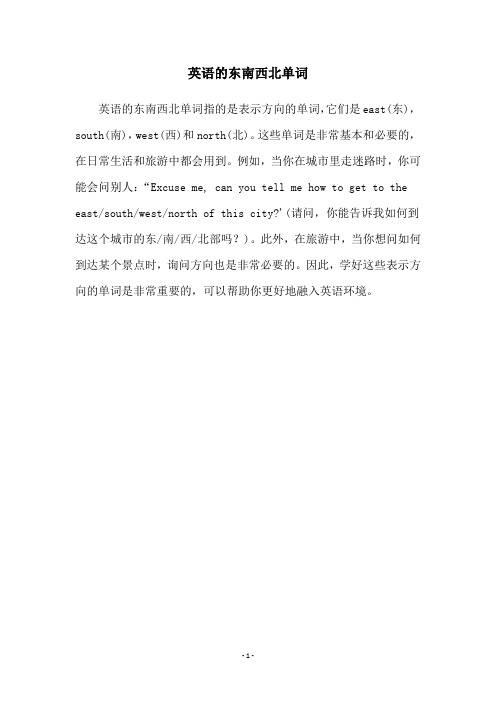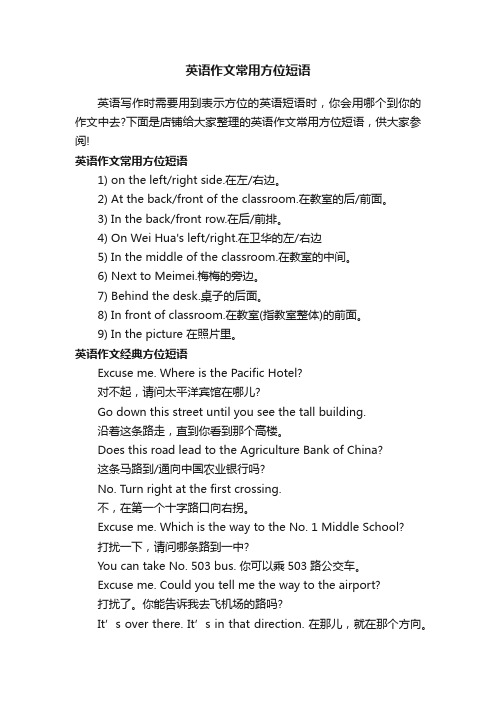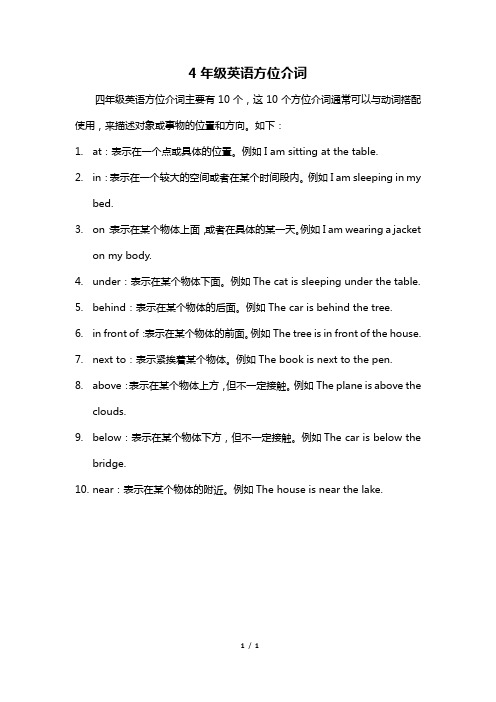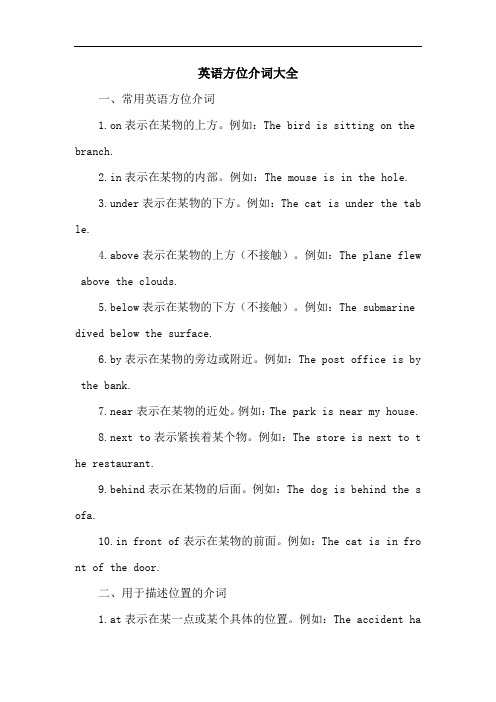英语方向表示方法
英语方位名词的用法

英语方位名词的用法英语中表示方位的东、西、南、北四个名词是east, west, south和north。
在使用时要注意以下几点:1. 在通常情况下,其前要加定冠词。
如:The sun rises in the east and sets in the west. 太阳从东方升起,至西方落下。
Better farmlands lie in the north of the state. 肥沃的农田分布在该国北部。
The north is less expensive to live in than the south. 北方的生活费用比南方低。
Go toward the south to get to Mexico from Texas. 向南走从德克萨斯州进入墨西哥。
但是,当强调方位对比时,可以不用冠词。
如:South is opposite north on a compass. 罗盘上南与北相对。
The direction opposite to north is south. 北的反方向是南。
East or west, home is best. 东好西好不如自己的家好。
有时表示纯方位,也可不用冠词。
如:I’m lost—which way is east? 我迷路了,哪边是东?另外,与from…to…连接的两个表示方位的名词,其前通常也不用冠词。
如:The river flows from north to south. 这条河从北向南流。
2. 表示“在……的东(南、西、北)”,通常应根据具体情况来选用介词。
(1) 以下各例的方位名词前用介词in,表示一地在另一地的范围之内。
如:China is in the east of Asia. 中国位于亚洲的东部。
The church is located in the east of the city. 教堂在本市的东部。
The capital is in the extreme south of the country. 首都位于这个国家的最南端。
英语中方位的表达句子

英语中⽅位的表达句⼦1. 英语中表⽰⽅位的短语above 正上⽅ at 在某⼀点 behind ⾝后 below 正下⽅ beside 旁边 between 两者之间 in front of 在。
前⾯(指两个物体,in front of the bus,你在车前,不是车内) in the front of 在..前⾯(在物体内部,如in the front of the bus,在公交厢的前⾯,你在车内) next to 紧挨着 on opposite 对⾯ outside 外⾯如outside the house over 在上⾯ under 在下⾯。
2. 在英语中有哪些表⽰⽅位的词我们已经学习了east, west, south, north, northeast, southeast等⼀些表⽰⽅位的词,在使⽤这些词表达⽅位时应注意以下⼏点: 1. 英汉表达的习惯不同:汉语中习惯把⽅位词的顺序排为“东西南北”;英语习惯则为north, south, east, west。
汉语中⽤“东南”、“东北”、“西南”、“西北”等表⽰⽅向,英语中则⽤southeast, northeast, southwest, northwest 表达。
2. 表⽰⽅位的名词east等⼀般应与定冠词the连⽤。
如: Shanghai is in the east of China.上海在中国的东部。
3. 表⽰⽅位的名词east, west等常与介词on, in, to连⽤,来表达两地的相互位置,但涵义却各有不同: 1)表⽰某地在某⼀特定区域内的⽅位时,介词⽤in。
如: Nanjing is in the south of Jiangsu. 南京在江苏的南部。
2)表⽰某地在某⼀特定区域外,且两地相互接壤的某⼀⽅位时,介词⽤on。
如: Henan is on the west of Shandong. 河南在⼭东的西部。
英语方位词知识分享

英语方位词的用法(一)in the east 与 on the east的区别1.in the east表示我们生活中和地理位置上的绝对方向。
如:The sun rises in the east and sets in the west.太阳从东边升起,从西边落下。
The Great Wall begins in the east from the Shanghaiguan Pass and ends at the Jiayu guan Pass in the west.长城东起山海关,西至嘉峪关。
2.on the east表示某事物位于另一事物所朝的方向。
这里的方向是相对而言的。
如:China faces the Pacific on the east. 中国东临太平洋。
The United States faces the Atlantic on the east and the Pacific on the west. 美国东临大西洋,西濒太平洋。
(二) in (to,on,at) the east of1.要表示A在B的东部,即:A在B的范围之内时就用"A is in the east of B",如:Japan is in the east of Asia.日本在亚洲东部。
Italy is in the south of Europe.意大利在欧洲南部。
2.如果A在B的东方,即:A在B的范围之外,且相隔有一定的距离,就用"A lies to the east of B".口语中有时可将to the省去。
如:Japan lies (to the) east of China.日本位于中国东方。
France lies (to the) east of England.法国位于英国东方。
3.如果A在B的东边(侧),即:A与B相邻接。
就用"A is on the east of B". 如: Guangdong is on the south of Hunan.广东在湖南南边。
英语的东南西北单词

英语的东南西北单词
英语的东南西北单词指的是表示方向的单词,它们是east(东),south(南),west(西)和north(北)。
这些单词是非常基本和必要的,在日常生活和旅游中都会用到。
例如,当你在城市里走迷路时,你可能会问别人:“Excuse me, can you tell me how to get to the east/south/west/north of this city?'(请问,你能告诉我如何到达这个城市的东/南/西/北部吗?)。
此外,在旅游中,当你想问如何到达某个景点时,询问方向也是非常必要的。
因此,学好这些表示方向的单词是非常重要的,可以帮助你更好地融入英语环境。
- 1 -。
英语作文常用方位短语

英语作文常用方位短语英语写作时需要用到表示方位的英语短语时,你会用哪个到你的作文中去?下面是店铺给大家整理的英语作文常用方位短语,供大家参阅!英语作文常用方位短语1) on the left/right side.在左/右边。
2) At the back/front of the classroom.在教室的后/前面。
3) In the back/front row.在后/前排。
4) On Wei Hua's left/right.在卫华的左/右边5) In the middle of the classroom.在教室的中间。
6) Next to Meimei.梅梅的旁边。
7) Behind the desk.桌子的后面。
8) In front of classroom.在教室(指教室整体)的前面。
9) In the picture 在照片里。
英语作文经典方位短语Excuse me. Where is the Pacific Hotel?对不起,请问太平洋宾馆在哪儿?Go down this street until you see the tall building.沿着这条路走,直到你看到那个高楼。
Does this road lead to the Agriculture Bank of China?这条马路到/通向中国农业银行吗?No. Turn right at the first crossing.不,在第一个十字路口向右拐。
Excuse me. Which is the way to the No. 1 Middle School?打扰一下,请问哪条路到一中?You can take No. 503 bus. 你可以乘503路公交车。
Excuse me. Could you tell me the way to the airport?打扰了。
你能告诉我去飞机场的路吗?It’s over there. It’s in that direction. 在那儿,就在那个方向。
英语方向表示方法

英语方向表示方法英语方向表示方法东方:East西方:West北方:North南方:South如in the+方位名词表示在范围之内on the+方位名词表示两地接壤to the+方位名词表示在范围之外(如美国与中国)on是相邻,to是不接壤,in是在境内果和中国接壤,像湖北和湖南,广东和广西这样在地理上接壤的就是相邻,用on,像中国和日本那样就叫相离,用to,特别注意的是,台湾在中国境内,要用in Hunan is on the south of HubeiShanghai is in the east of China. Taiwan is in the southeast of China.Japan is to the east of China2英语方位的表达1:A lies on the 方向of B : A 位于B的某个方向(且两地接壤)A lies to the 方向ofB : A 位于B的某个方向(不接壤) Beijing lies to Shanghai.lie off :“在离……的海上”。
例如They lie on the island off the coast of Guangdong.2.northeast 的意思是东北部,是名词。
northeastern的意思是东北的; 来自东北的; 向东北的; 东北部的,词性是形容词,用来修饰名词,用法就会不同了3.north china是中国北部,northeastern china是中国东北3表示方位的英语单词上面on 下面behind, 左面left 右面right east东west西south南north北northeast东北northwest西北southeast东南southwest西南front前面in front在前面;当面in front of在…前面;当…面after在...之后, 在...后面back后面的, 在后面behind在...之后left左边right右边above 在...上方on top of在...之上over在...之上below\/down在...下面about在附近against与…相反ahead在…之前aimless无方向的along顺着,向前4英语介词表示方向怎么区分to表示动作的方向,或目的地,例如:The dog went to the boy.Have you ever been to a basketball game?He went to New York.at可以表示动作所瞄准的目标,例如:The boy threw the bone at the dog.Look at the blackboard.The crowd threw stones at the police.for表示“前往”,即要到达的目的地。
4年级英语方位介词

4年级英语方位介词
四年级英语方位介词主要有10个,这10个方位介词通常可以与动词搭配使用,来描述对象或事物的位置和方向。
如下:
1.at:表示在一个点或具体的位置。
例如I am sitting at the table.
2.in:表示在一个较大的空间或者在某个时间段内。
例如I am sleeping in my
bed.
3.on:表示在某个物体上面,或者在具体的某一天。
例如I am wearing a jacket
on my body.
4.under:表示在某个物体下面。
例如The cat is sleeping under the table.
5.behind:表示在某个物体的后面。
例如The car is behind the tree.
6.in front of:表示在某个物体的前面。
例如The tree is in front of the house.
7.next to:表示紧挨着某个物体。
例如The book is next to the pen.
8.above:表示在某个物体上方,但不一定接触。
例如The plane is above the
clouds.
9.below:表示在某个物体下方,但不一定接触。
例如The car is below the
bridge.
10.near:表示在某个物体的附近。
例如The house is near the lake.
1/ 1。
英语方位介词大全

英语方位介词大全一、常用英语方位介词1.on表示在某物的上方。
例如:The bird is sitting on the branch.2.in表示在某物的内部。
例如:The mouse is in the hole.3.under表示在某物的下方。
例如:The cat is under the tab le.4.above表示在某物的上方(不接触)。
例如:The plane flew above the clouds.5.below表示在某物的下方(不接触)。
例如:The submarine dived below the surface.6.by表示在某物的旁边或附近。
例如:The post office is by the bank.7.near表示在某物的近处。
例如:The park is near my house.8.next to表示紧挨着某个物。
例如:The store is next to t he restaurant.9.behind表示在某物的后面。
例如:The dog is behind the s ofa.10.in front of表示在某物的前面。
例如:The cat is in fro nt of the door.二、用于描述位置的介词1.at表示在某一点或某个具体的位置。
例如:The accident happened at the intersection of two roads.2.in表示在一个较大的范围内或某个封闭的空间内。
例如:She lives in the city center.3.on表示在一个物体的表面或上方。
例如:The book is on the table.4.under表示在另一个物体的下方或内部。
例如:The box cont ains a book,and the book is under the lid of the box.5.above表示在一个物体的上方,但不一定紧挨着该物体。
- 1、下载文档前请自行甄别文档内容的完整性,平台不提供额外的编辑、内容补充、找答案等附加服务。
- 2、"仅部分预览"的文档,不可在线预览部分如存在完整性等问题,可反馈申请退款(可完整预览的文档不适用该条件!)。
- 3、如文档侵犯您的权益,请联系客服反馈,我们会尽快为您处理(人工客服工作时间:9:00-18:30)。
英语方向表示方法
英语方向表示方法
东方:East
西方:West
北方:North
南方:South
如in the+方位名词表示在范围之内
on the+方位名词表示两地接壤
to the+方位名词表示在范围之外 (如美国与中国)
on是相邻,to是不接壤,in是在境内果和中国接壤,
像湖北和湖南,广东和广西这样在地理上接壤的就是相邻,用on,像中国和日本那样就叫相离,用to,特别注意的是,台湾在中国境内,要用in
Hunan is on the south of Hubei
Shanghai is in the east of China. Taiwan is in the southeast of China.
Japan is to the east of China
2英语方位的表达
1:A lies on the 方向 of B : A 位于B的某个方向(且两地接壤)
A lies to the 方向 of
B : A 位于B的某个方向(不接壤) Beijing lies to Shanghai.
lie off :在离的海上。
例如 They lie on the island off the coast of Guangdong.
2.northeast 的意思是东北部,是名词。
northeastern的意思是东北的; 来自东北的; 向东北的; 东北部的,词性是形容词,用来修饰名词,用法就会不同了
3.north china是中国北部,northeastern china是中国东北
3表示方位的英语单词
上面 on 下面 behind, 左面 left 右面 right east东 west 西 south南 north北 northeast东北 northwest西北southeast东南 southwest西南 front前面 in front在前面;当面 in front of在前面;当面 after在...之后, 在...后面 back 后面的, 在后面 behind在...之后 left左边 right右边 above 在...上方 on top of在...之上 over在...之上 below\/down 在...下面 about在附近 against与相反 ahead在之前 aimless 无方向的 along顺着,向前
4英语介词表示方向怎么区分
to表示动作的方向,或目的地,例如:
The dog went to the boy.
Have you ever been to a basketball game
He went to New York.
at可以表示动作所瞄准的目标,例如:
The boy threw the bone at the dog.
Look at the blackboard.
The crowd threw stones at the police.
for表示前往,即要到达的目的地。
如:
Ill leave New York for Washington tomorrow.
I dont know when they left for Washington. The train for Washington has already arrived.。
